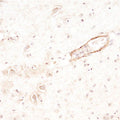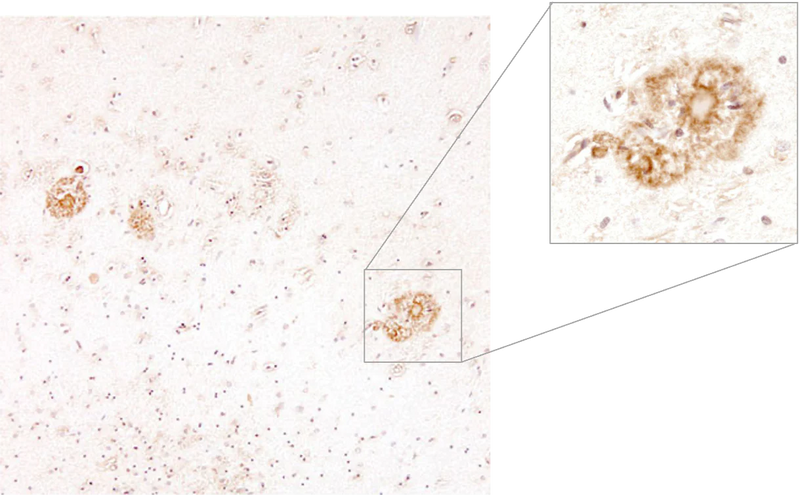Anti-Beta-Amyloid Peptide (N-terminus) Antibody
Beta-Amyloid peptide antibodies were generated against a KLH-conjugated N-terminal sequence contained within both the 40- and 42-amino acid versions of the human Beta-Amyloid peptide (i.e., DAE FRH DSG YEV HHQ KL) (Amyloid Precursor Protein residues #672-688).
SKU: ABN
Ships: 1-2 business days
Product Details
Beta-Amyloid Peptide (N-terminus)
Beta-Amyloid peptide is a 40- or 42-amino acid fragment of the human Beta-Amyloid Peptide: Precursor Protein (770 amino acids) produced by the proteolytic actions of Beta and Gamma-secretases. Both forms of Beta-Amyloid peptide are rather insoluble and tend to self-aggregate into distinctive extracellular "plaques." These plaques are evident in brains from patients with Alzheimer's disease as well as in brains from individuals with a history of traumatic head injuries. In the case of Alzheimer's disease, it has been suggested that these extracellular Beta-Amyloid peptide plaques are themselves cytotoxic (rather than simply being markers of brain pathology), and are responsible for the dendritic pruning and other neurodegenerative changes seen.
Affinity-Purified IgY
100 µg/mL
Polyclonal
IgY
IHC
Chicken
APP A4 AD1
N/A
Synthetic peptide (DAE FRH DSG YEV HHQ KL) contained within both the 40- and 42 amino acid versions of the human Beta-Amyloid peptide (Amyloid Precursor Protein residues #672-688).
Human
Human, Mouse, Rat
AB_2313536
Store at 4°C in the dark. Under these conditions, the antibodies should have a shelf life of at least twelve months, provided they remain sterile. For longer term storage, aliquot and freeze to avoid freeze-thaw of the antibody.
Liquid
Chickens were immunized with a synthetic peptide (corresponding to DAE FRH DSG YEV HHQ KL, residues #1-17 of the amyloid beta-peptide) coupled to keyhole limpet hemocyanin (KLH). After repeated injections, immune eggs were collected, and the IgY fractions were purified from the yolks. These IgY fractions were then affinity-purified using a peptide column to which the same peptide was attached. Finally, the antibody concentration was adjusted to 100 µg/ml and filter-sterilized.
Phosphate-buffered (10 mM) isotonic (0.9%, w/v) saline ("PBS," pH 7.2) with sodium azide (0.02%, w/v) added as a preservative.
IHC: 1:2000-1:5000
ICC: 1:2000-1:5000
ICC: 1:2000-1:5000
Antibodies were analyzed by immunohistochemistry (at a concentration of 3 µg/mL) using fluorescein-labeled goat anti-chicken IgY (1:500 dilution, Aves Labs Cat.# F-1005) or HRP-labeled goat anti-chicken IgY (1:2000 dilution, Aves Labs, Cat.# H-1004) as the secondary reagent.
These antibodies are to be used as research laboratory reagents and are not for use as diagnostic or therapeutic reagents in humans.
United States
12 months from receipt of product
Amyloid-beta A4 protein (ABPP) (APPI) (Alzheimer disease amyloid protein) (Amyloid precursor protein) (Amyloid-beta precursor protein) (Cerebral vascular amyloid peptide) (CVAP) (PreA4) (Protease nexin-II) (PN-II) [Cleaved into: N-APP; Soluble APP-alpha (S-APP-alpha); Soluble APP-beta (S-APP-beta); C99 (Beta-secretase C-terminal fragment) (Beta-CTF); Amyloid-beta protein 42 (Abeta42) (Beta-APP42); Amyloid-beta protein 40 (Abeta40) (Beta-APP40); C83 (Alpha-secretase C-terminal fragment) (Alpha-CTF); P3(42); P3(40); C80; Gamma-secretase C-terminal fragment 59 (Amyloid intracellular domain 59) (AICD-59) (AID(59)) (Gamma-CTF(59)); Gamma-secretase C-terminal fragment 57 (Amyloid intracellular domain 57) (AICD-57) (AID(57)) (Gamma-CTF(57)); Gamma-secretase C-terminal fragment 50 (Amyloid intracellular domain 50) (AICD-50) (AID(50)) (Gamma-CTF(50)); C31]
Ice packs




